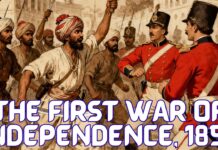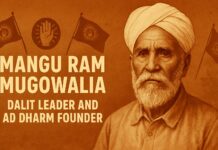The Battles of Panipat: Three Pivotal Conflicts That Shaped Indian History
The three Battles of Panipat, fought over a span of 235 years (1526-1761), represent some of the most decisive military engagements in Indian history. These conflicts fundamentally altered the political landscape of the subcontinent, establishing empires, consolidating power, and reshaping the balance of forces across North India. Each battle introduced revolutionary military tactics and technologies that transformed warfare in the region, while their outcomes reverberated through centuries of subsequent history. [1][2][3][4][5][6]
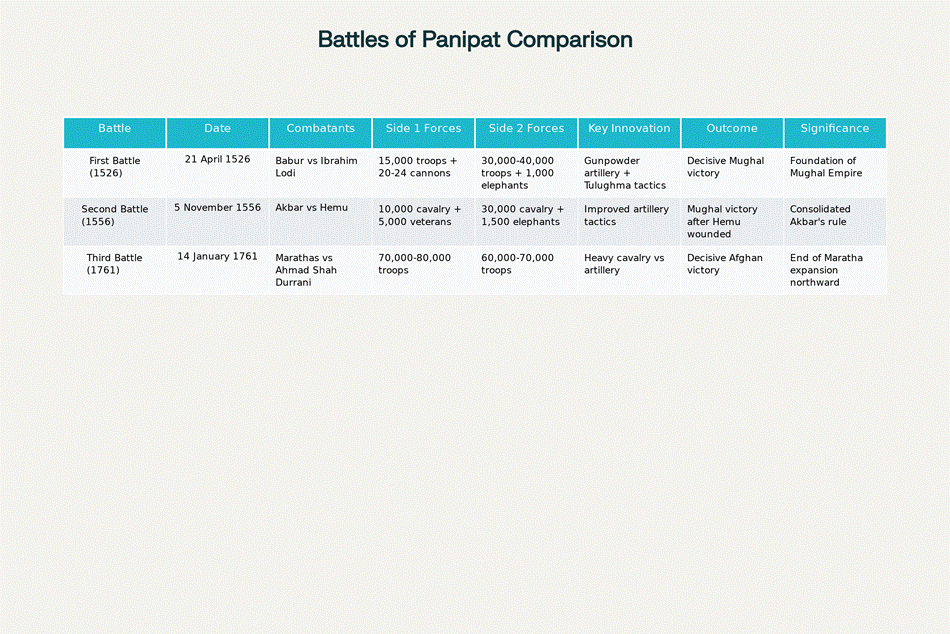
Comprehensive Comparison of the Three Battles of Panipat (1526, 1556, 1761)
The Strategic Significance of Panipat
Geographic and Military Importance
Panipat’s emergence as India’s most significant battlefield was no historical accident. Located approximately 90 kilometers north of Delhi in present-day Haryana, the city occupied a strategically crucial position on the Grand Trunk Road, one of Asia’s oldest and longest trade routes connecting Central Asia to the Indian subcontinent. This ancient highway, known in earlier times as Uttarapatha and later rebuilt by Sher Shah Suri as Sadak-e-Azam, served as the primary corridor for invasions, migrations, and trade for over 2,500 years. [7][8][9]
The flat, expansive plains surrounding Panipat provided ideal terrain for large-scale military operations. Unlike mountainous or forested regions that could fragment armies and limit tactical options, Panipat’s open fields allowed for the deployment of massive forces, cavalry charges, artillery positioning, and complex battle formations. The presence of the Yamuna River and natural water sources ensured adequate supplies for extended military campaigns, while the proximity to Delhi made control of Panipat synonymous with control over the gateway to India’s political heartland. [8][10][7]
The Gateway to Empire
Throughout medieval Indian history, ambitious rulers recognized that whoever controlled Panipat effectively controlled access to Delhi and, by extension, dominion over North India. The city’s position made it the last major defensive point before the capital, transforming it into a natural chokepoint where empires would rise or fall based on their ability to secure this crucial terrain. The strategic importance was further amplified by Panipat’s role as a commercial hub, where control meant access to valuable trade revenues, supplies, and manpower essential for sustaining large military operations. [7][8]
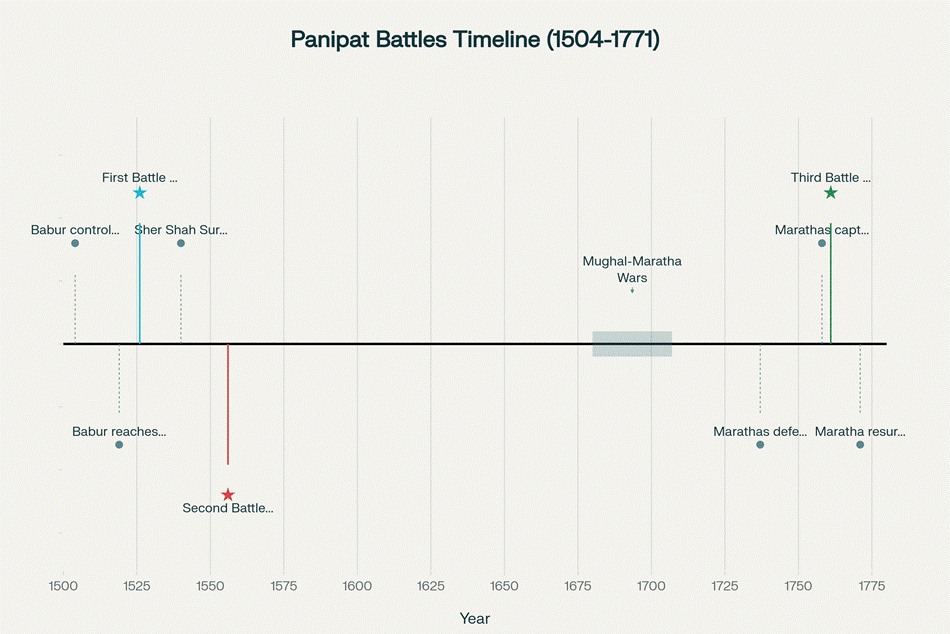
Timeline of the Battles of Panipat and Historical Context (1504-1771)
The First Battle of Panipat (1526): Foundation of the Mughal Empire
Background and Context
The First Battle of Panipat emerged from the convergence of several critical factors in early 16th-century North India. Zahir-ud-din Babur, a Timurid prince who had lost his ancestral kingdom of Samarkand, turned his ambitions toward Hindustan as a means of fulfilling his imperial destiny. After establishing control over Kabul and Ghazni in 1504, Babur spent the next two decades consolidating his position and preparing for his Indian campaign.[1][2][3][4][5]
The Delhi Sultanate under Ibrahim Lodi presented an opportune target. By 1524, the Lodi Empire was plagued by internal rebellions, with governors like Daulat Khan Lodi of Punjab and Ala-ud-Din actively inviting Babur to challenge Ibrahim’s authority. The sultanate’s weakening central control, combined with the feudal lords’ dissatisfaction with Ibrahim’s harsh rule, created the perfect conditions for an external intervention.[2][3][1]
Military Preparations and Forces
Babur’s army, though significantly outnumbered, possessed several critical advantages that would prove decisive. His force of approximately 15,000 men was equipped with 20-24 pieces of field artillery, representing one of the earliest introductions of massed gunpowder weapons to Indian warfare. Under the guidance of Ottoman artillery master Ustad Ali Quli, Babur’s forces had mastered advanced siege craft and battlefield tactics that had proven successful against the Safavid Empire.[1][2][3][4][11]
In contrast, Ibrahim Lodi commanded a traditionally organized army estimated between 30,000-40,000 fighting men, supported by over 1,000 war elephants. While impressive in numbers, this force relied on conventional tactics that had dominated Indian battlefields for centuries but were increasingly vulnerable to the new realities of gunpowder warfare.[2][3][4][5][1]
Revolutionary Military Tactics
The First Battle of Panipat, fought on 21 April 1526, marked a watershed moment in military history through Babur’s introduction of two revolutionary tactical innovations. The Tulughma system divided his entire army into specialized units: Left, Right, and Center divisions, with each further subdivided into Forward and Rear components. This organizational structure allowed a smaller force to achieve tactical flexibility and envelop larger enemy formations from multiple directions simultaneously.[1][2][3][12][13]
The Araba defensive system represented equally groundbreaking innovation. Babur positioned hundreds of bullock carts in rows facing the enemy, tied together with animal hide ropes to create an integrated defensive barrier. Behind this mobile fortification, artillery and matchlock soldiers could fire with minimal risk while maintaining the ability to reposition weapons as battlefield conditions changed. The combination of these tactics with sustained artillery bombardment created a defensive-offensive hybrid that maximized Babur’s technological advantages.[2][3][12][13][1]
The Course of Battle
The battle commenced at dawn with Ibrahim Lodi’s traditional frontal assault, spearheaded by war elephants intended to break Babur’s formations through sheer mass and psychological intimidation. However, Babur’s cannons created an unprecedented sensory assault that fundamentally disrupted this ancient tactical paradigm. The thunderous noise, acrid smoke, and devastating impact of artillery fire panicked the war elephants, causing them to turn and trample Lodi’s own infantry.[1][2][3][11]
As Lodi’s center collapsed under friendly fire from his own elephants, Babur executed the Tulughma maneuver with devastating precision. His flanking units enveloped the disorganized Sultanate forces while his center maintained steady fire from behind the Araba barriers. Ibrahim Lodi himself was killed during the battle, along with an estimated 15,000-20,000 of his soldiers, effectively ending both the battle and the Lodi dynasty.[2][3][5][12][1]
Consequences and Significance
Babur’s victory at Panipat established the Mughal Empire and fundamentally transformed the nature of warfare in the Indian subcontinent. The introduction of gunpowder weapons, field artillery, and systematic tactical organization marked the beginning of a new era in which technological superiority and strategic innovation could overcome traditional advantages in numbers and conventional military strength. The battle’s outcome demonstrated that the future belonged to rulers who could adapt to changing military realities rather than those who relied solely on inherited methods and resources.[1][2][3][5]

Artistic depiction of the First Battle of Panipat with key figures and battle scene.
The Second Battle of Panipat (1556): Consolidating Mughal Power
Political Upheaval and Opportunity
The Second Battle of Panipat arose from the succession crisis following Humayun’s death in January 1556. The 13-year-old Akbar’s accession to the Mughal throne created a power vacuum that ambitious rivals quickly moved to exploit. The most formidable challenger was Hem Chandra Vikramaditya, known simply as Hemu, a Hindu general who had served as Prime Minister under the Sur dynasty and had achieved an remarkable string of 22 consecutive military victories between 1553 and 1556.[14][15][16][17]
Hemu’s rise represented more than mere political opportunism; it embodied a broader Hindu resurgence against Muslim rule in North India. After defeating Mughal forces under Tardi Beg Khan at the Battle of Delhi in October 1556, Hemu proclaimed himself Raja Vikramaditya at Purana Qila, establishing what he claimed would be the restoration of Hindu sovereignty after nearly 350 years of Muslim dominance.[15][16][17][14]
Military Confrontation
The armies that faced each other at Panipat on 5 November 1556 represented starkly different military philosophies and organizational structures. Hemu commanded approximately 30,000 cavalry troops supported by 1,500 war elephants and a substantial artillery park, reflecting the continued reliance on traditional Indian military methods. His forces included experienced Afghan and Rajput cavalry, creating a formidable combination of mobility and striking power.[14][15][16][17]
The Mughal army under Bairam Khan’s command consisted of roughly 10,000 cavalry supplemented by 5,000 veteran soldiers. Though significantly outnumbered, these forces had been trained in the tactical innovations pioneered by Babur, including improved artillery deployment and coordinated cavalry operations. Akbar himself remained eight miles from the battlefield under heavy guard, reflecting both his youth and the dynasty’s recognition that the empire’s survival depended on this single engagement.[15][17][14]
The Decisive Moment
The Second Battle of Panipat initially favored Hemu’s forces, which pressed their numerical advantage aggressively against Mughal positions. Contemporary chronicler Abul Fazl described the engagement as so fierce that “two armies so collided that struck fire out of the water, the air was all crimsoned”. Hemu personally led his forces from atop his war elephant named Hawai, directing tactical movements while maintaining the morale and cohesion of his diverse army.[14][15][16][17]
However, the battle’s outcome hinged on a single, devastating moment. A Mughal arrow struck Hemu in the eye, causing him to fall unconscious on his elephant. His troops, seeing their leader apparently dead or incapacitated, panicked and fled the battlefield in disorder. This psychological collapse transformed a tactical stalemate into a complete Mughal victory, demonstrating how medieval warfare often depended as much on leadership visibility as on tactical superiority.[15][16][17][14]
Aftermath and Consolidation
Following Hemu’s capture and execution by Bairam Khan, the Mughal forces secured complete control over Delhi and Agra, establishing Akbar’s authority over the crucial Delhi-Agra corridor. The victory eliminated the most serious threat to nascent Mughal power while simultaneously ending the last major attempt to restore Hindu political dominance in North India through military conquest. The battle’s outcome enabled Akbar’s subsequent territorial expansion and the consolidation of Mughal administrative systems throughout northern India.[14][15][17]
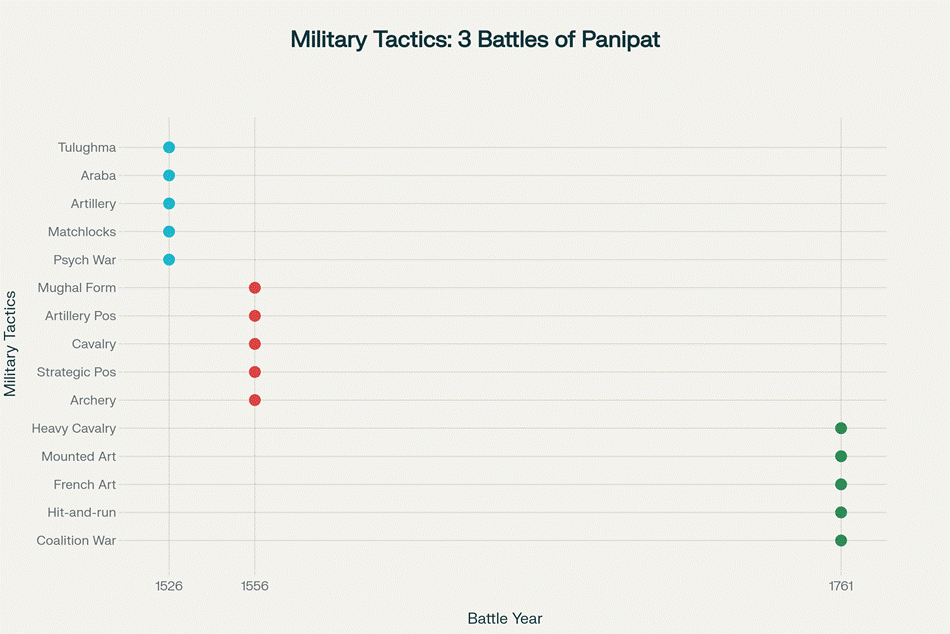
Military Innovations and Tactics Across the Three Battles of Panipat
The Third Battle of Panipat (1761): The End of Maratha Ascendancy
The Rise of Maratha Power
By the mid-18th century, the Maratha Empire had emerged as the dominant power across much of the Indian subcontinent. Following the 27-year Mughal-Maratha War (1680-1707), Maratha forces under successive Peshwas had systematically expanded their territorial control. Under Baji Rao I, the Marathas had secured dominance over Gujarat, Malwa, and Rajputana, culminating in their victory near Delhi in 1737 that brought much of the former Mughal territories under Maratha control.[18][19][20][21][22]
The Maratha expansion reached its zenith under Peshwa Balaji Baji Rao, when Maratha forces invaded Punjab in 1758 and expelled Ahmad Shah Durrani’s son Timur Shah from the region. This direct challenge to Afghan sovereignty in Punjab brought the Marathas into inevitable confrontation with Ahmad Shah Durrani, who viewed the loss of this wealthy province as an existential threat to his empire.[19][20][18]
The Afghan Response
Ahmad Shah Durrani, ruler of the Durrani Empire centered in Afghanistan, represented one of the most formidable military commanders of his era. His previous invasions of India between 1748 and 1767 had established him as a master of mobile warfare and coalition building. Unlike previous foreign invaders who sought permanent territorial conquest, Durrani combined the strategic objectives of plunder and political influence with sophisticated diplomatic alliances among India’s Muslim rulers.[18][19][20]
The Third Battle of Panipat developed from Durrani’s determination to restore Afghan control over Punjab and reassert Muslim political authority in North India. His invasion force included not only his core Afghan troops but also crucial Indian allies: the Rohilla Afghans of the Doab under Najib-ud-Daula and Shuja-ud-Daula, the Nawab of Oudh. This coalition strategy enabled Durrani to present his campaign not as a foreign invasion but as a restoration of legitimate Muslim rule against Maratha expansion.[19][20][22][18]
Military Preparations and Forces
The armies that converged on Panipat in January 1761 represented the largest military concentration in 18th-century Indian warfare. Maratha forces under Sadashivrao Bhau numbered approximately 70,000-80,000 soldiers, including substantial infantry, cavalry, and French-supplied artillery units. The Maratha army also included an estimated 120,000 pilgrims and camp followers, transforming the military expedition into a massive population movement that complicated logistics and battlefield management.[18][19][21][23][24][22]
Ahmad Shah Durrani commanded roughly 60,000-70,000 troops, but his forces possessed superior mobility, battlefield experience, and unified command structure. The Afghan coalition included heavy cavalry trained in Central Asian warfare tactics, mounted artillery (zamburak and jezail), and the crucial advantage of fighting on familiar terrain with established supply lines.[19][24][22][18]
The Course of the Battle
The Third Battle of Panipat, fought on 14 January 1761, unfolded in three distinct phases that demonstrated both the scale of the conflict and the evolution of 18th-century military tactics. Initially, Maratha forces gained tactical advantages through their superior artillery, pushing back Afghan positions and appearing to control the battlefield’s momentum. The Maratha center under Sadashivrao Bhau maintained strong defensive positions while their cannons inflicted significant casualties on Durrani’s forces.[18][25]
However, Ahmad Shah Durrani’s tactical brilliance became evident during the battle’s second phase. He employed feigned retreat tactics to draw Maratha cavalry into exposed positions, then launched coordinated flanking attacks that exploited gaps in Maratha formations. The death of Vishwasrao, the Peshwa’s eldest son, during the afternoon fighting dealt a devastating psychological blow to Maratha morale. When Sadashivrao Bhau was also killed later in the battle, Maratha resistance collapsed entirely.[25]
Casualties and Consequences
The Third Battle of Panipat resulted in one of the bloodiest single days in pre-modern Indian warfare, with estimated casualties ranging from 60,000-70,000 killed, though some sources suggest total fatalities including civilians may have reached 100,000. The scale of destruction was so massive that contemporary observers compared it to natural disasters in its impact on regional demographics.[18][20][21][26][27]
The battle’s outcome fundamentally altered the balance of power in 18th-century India. The Maratha Empire’s northern expansion was permanently halted, while their military power was so severely weakened that they required a decade to recover. This power vacuum created opportunities for regional powers including the Sikhs, Rajputs, and Jats to assert greater independence, contributing to the political fragmentation that would facilitate subsequent British expansion.[20][22][18]
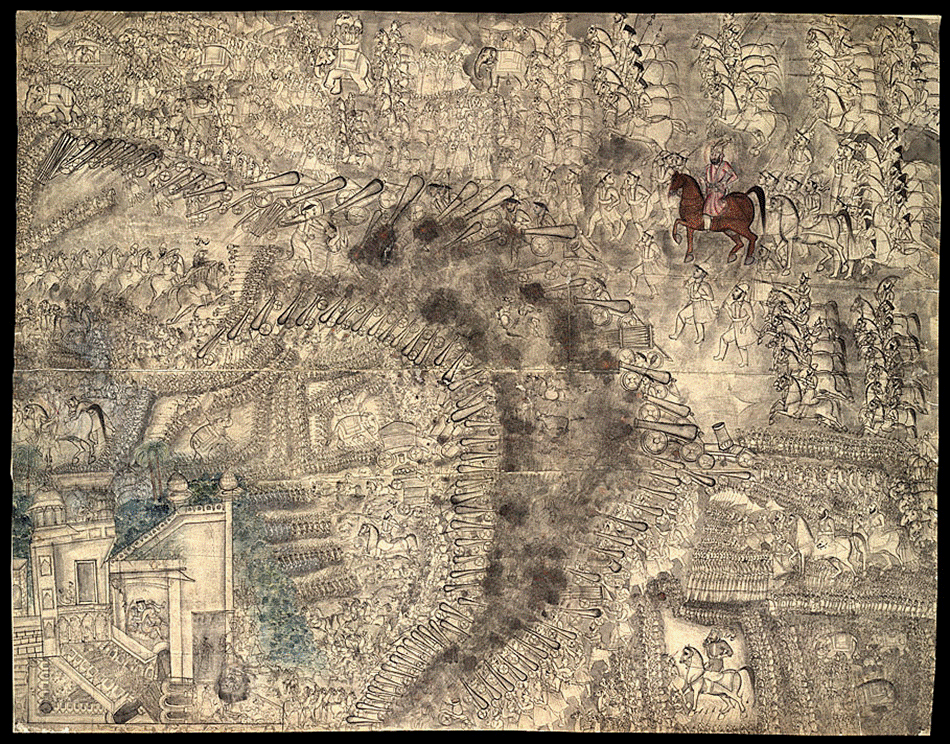
Historical illustration of the Third Battle of Panipat (1761) showing detailed troop formations and battlefield strategies.
Military Innovations and Technological Evolution
The Gunpowder Revolution
The three Battles of Panipat collectively chronicle the introduction and evolution of gunpowder warfare in the Indian subcontinent. Babur’s victory in 1526 marked the decisive moment when traditional Indian military methods—centered on war elephants, cavalry charges, and mass infantry formations—encountered the technological superiority of firearms and artillery. The psychological impact of cannon fire proved as important as its physical destructiveness, fundamentally altering battlefield dynamics and forcing rapid adaptation of military tactics.[11][28][12]
The evolution of artillery technology across the three battles demonstrates the rapid pace of military innovation during this period. While Babur’s cannons were relatively simple bronze weapons requiring complex logistics and positioning, by 1761 both Maratha and Afghan forces employed sophisticated artillery systems including French-supplied cannons, mobile mounted artillery (zamburak), and specialized anti-personnel weapons. This technological arms race reflected broader global patterns in which military success increasingly depended on access to advanced weaponry and the tactical knowledge to employ it effectively.[29][11]
The Decline of War Elephants
The three battles also document the gradual obsolescence of war elephants as a dominant military force in Indian warfare. At the First Battle of Panipat, Ibrahim Lodi’s 1,000 war elephants represented the pinnacle of traditional Indian military power, yet they became liabilities when confronted with gunpowder weapons. The sound and smoke of artillery fire caused elephants to panic and trample their own forces, transforming what had been shock troops into sources of friendly-fire casualties.[28][30]
By the Second Battle of Panipat, Hemu’s 1,500 war elephants still played important roles in transportation and command functions, but their tactical effectiveness had diminished substantially. The Third Battle of Panipat marked the final appearance of elephants in major Indian field armies, as military commanders recognized that their vulnerabilities outweighed their traditional advantages. This transition reflected broader changes in warfare that prioritized mobility, firepower, and tactical flexibility over the mass and psychological intimidation that had characterized earlier military systems.[30][28]
Long-term Historical Impact
Political Transformation
The three Battles of Panipat collectively reshaped the political geography of the Indian subcontinent across nearly two and a half centuries. The First Battle established the Mughal Empire, which would dominate North Indian politics for over 200 years and create administrative and cultural systems that influenced the region long after Mughal political power had declined. The Second Battle consolidated this Mughal dominance under Akbar, enabling the territorial expansion and administrative innovations that transformed a conquest state into a stable empire.[1][14][2][15][3][16]
The Third Battle’s outcome created the political fragmentation that characterized late 18th-century India. The Maratha defeat removed the last indigenous power capable of unifying the subcontinent under native rule, creating regional power vacuums that various local rulers, European trading companies, and foreign invaders would attempt to fill. This fragmentation proved crucial to subsequent British expansion, as the East India Company could exploit inter-regional conflicts and the absence of coordinated resistance to establish colonial dominance.[18][20][22]
Cultural and Social Consequences
Beyond their immediate political impact, the Battles of Panipat influenced Indian cultural and social development in profound ways. The Mughal victory in 1526 introduced Persian administrative practices, architectural styles, and cultural traditions that became integral to North Indian civilization. The synthesis of Central Asian, Persian, and Indian traditions that emerged during Mughal rule created new artistic, literary, and architectural forms that defined Indo-Islamic culture.[1][2]
The Third Battle’s aftermath had equally significant cultural implications. The Maratha defeat ended the most successful Hindu political revival of the medieval period, while the subsequent political chaos contributed to social instability and economic disruption across much of North India. These conditions accelerated processes of cultural change and social adaptation that would shape Indian society’s response to subsequent challenges, including the eventual establishment of British colonial rule.[18][20][22]
Conclusion
The three Battles of Panipat represent defining moments in Indian history, each marking crucial transitions in political power, military technology, and cultural development. From Babur’s introduction of gunpowder warfare in 1526 to the crushing defeat of Maratha expansion in 1761, these conflicts demonstrate how military innovation, strategic leadership, and tactical adaptation could determine the fate of empires and reshape the destiny of entire civilizations.[1][18][2][20]
The battles’ enduring significance extends beyond their immediate military outcomes. They illustrate fundamental themes in Indian history: the tension between traditional and innovative military methods, the challenges of maintaining political unity across diverse territories, and the complex interplay between foreign invasion and indigenous resistance. The strategic importance of Panipat itself—arising from geography, infrastructure, and proximity to political power—exemplifies how certain locations become focal points for historical change.[18][2][20][7][8][10][1]
Most importantly, the Battles of Panipat demonstrate that military success in pre-modern India required not just numerical superiority or traditional strength, but the ability to adapt to changing circumstances, embrace technological innovation, and execute sophisticated strategic planning. These lessons remained relevant long after the smoke cleared from Panipat’s plains, influencing military thinking and political strategy throughout the subsequent colonial period and into modern times. Understanding these battles therefore provides crucial insights not only into medieval Indian history but into the broader patterns of political change, technological adaptation, and cultural transformation that have shaped the Indian subcontinent across centuries.[2][20][1][18]
- https://www.gscepublications.com/gk/91614094-05c1-4fac-b047-8a4edc3479a7_GKMaterial.pdf
- https://vajiramandravi.com/upsc-exam/first-battle-of-panipat/
- https://panipat.gov.in/first-battle/
- https://en.wikipedia.org/wiki/First_Battle_of_Panipat
- https://testbook.com/ias-preparation/first-battle-of-panipat-1526
- https://www.jagranjosh.com/general-knowledge/first-battle-of-panipat-1746016547-1
- https://superkalam.com/upsc-mains/previous-year-question-paper/2014/the-third-battle-of-panipat-was-fought-in-why-were-so-many-empireshaking-battles-fought-at-panipat-b3df028e-01ca-46aa-8139-6fdd52a1ebf1
- https://questions.redpapr.com/2014/gs1/4
- https://en.wikipedia.org/wiki/Grand_Trunk_Road
- https://www.indiatvnews.com/photos/india-why-did-panipat-become-a-frequent-battlefield-that-shaped-indian-history-2025-07-10-998257
- https://en.wikipedia.org/wiki/Mughal_artillery
- https://www.cheggindia.com/general-knowledge/first-battle-of-panipat/
- https://www.drishtiias.com/paper1/battles-of-panipat
- https://www.mughallibrary.com/images-1/second-battle-of-panipat
- https://www.cheggindia.com/general-knowledge/second-battle-of-panipat/
- https://en.wikipedia.org/wiki/Second_Battle_of_Panipat
- https://vajiramandravi.com/upsc-exam/second-battle-of-panipat/
- https://panipat.gov.in/third-battle/
- https://en.wikipedia.org/wiki/Third_Battle_of_Panipat
- https://vajiramandravi.com/upsc-exam/third-battle-of-panipat/
- https://byjus.com/ias-questions/the-third-battle-of-panipat-was-fought-in-the-year/
- https://www.drishtiias.com/to-the-points/paper1/battles-of-panipat
- https://en.wikipedia.org/wiki/Panipat
- https://www.geeksforgeeks.org/social-science/third-battle-of-panipat-january-14-1761/
- https://superkalam.com/upsc-mains/notes/third-battle-panipat
- https://testbook.com/ias-preparation/third-battle-of-panipat-ncert-notes
- https://forumias.com/blog/third-battle-of-panipat-1761/
- https://warhistory.org/@msw/article/indian-war-elephants
- https://www.studysmarter.co.uk/explanations/history/the-mughal-empire/mughal-military/
- https://www.reddit.com/r/history/comments/fvnphn/how_effective_were_war_elephants_in_ancient/
- https://panipat.gov.in/second-battle/
- https://testbook.com/ias-preparation/second-battle-of-panipat-1556
- https://www.youtube.com/watch?v=s9BXnaUegn0
- https://www.vedantu.com/question-answer/hemu-whom-akbar-defeated-in-the-second-battle-of-class-8-social-science-cbse-60cc0de12f7a4d284f8e70b8
- https://haryana.pscnotes.com/haryana-history/battles-of-panipat-in-haryana/
- https://pwonlyias.com/pyq/the-third-battle-of-panipat-was-fought-in-1761-why-were-so-many-empire-shaking-battles-fought-at-panipat-150-words-10-marks/
- https://blog.lukmaanias.com/2025/02/24/q-58-the-third-battle-of-panipat-was-fought-in-1761-why-were-so-many-empire-shaking-battles-fought-at-panipat-gs-i-historyupsc-cse-2014150-words-10-marks/
- https://fotisedu.com/why-panipat-had-been-a-favourite-battlefield-in-indian-history/
- https://prepp.in/news/e-492-3rd-battle-of-panipat-1761-modern-india-history-notes
- https://panipat.gov.in/places-of-interest/
- https://indianhistorycollective.com/rajputempire-mughalsinindia-hindustan-bharatiya-arms-bharathiraja-bharatcountry-firearmsofindia-ammunition-firearms/
- https://www.youtube.com/watch?v=_pN96DVPsCk
- https://www.mmccollege.co.in/FileNotice/32 AFirearms.pdf
- https://www.vifindia.org/print/13331
- https://en.wikipedia.org/wiki/Army_of_the_Mughal_Empire
- https://historyfinder.in/first-battle-of-panipat-6-critical-factors-that-favoured-babur/
- https://www.scribd.com/document/649168861/GUNPOWDER-AND-FIREARMS-DURING-MUGHAL-IND











